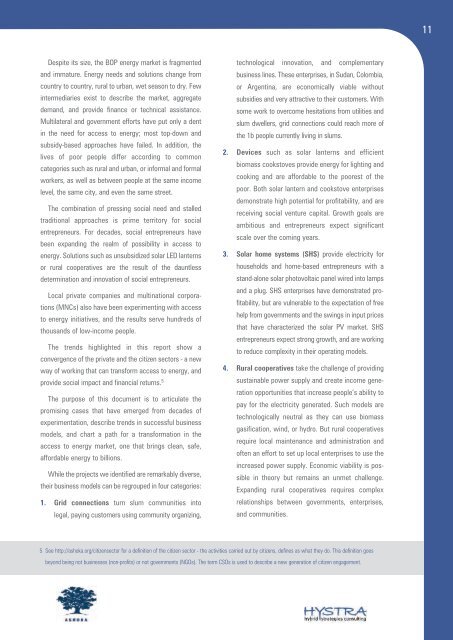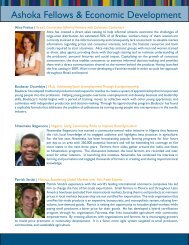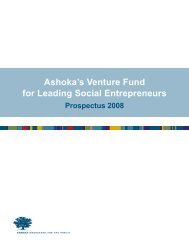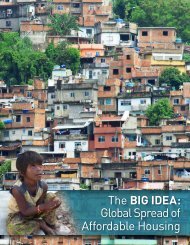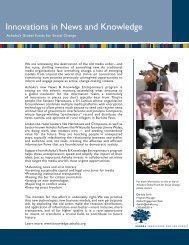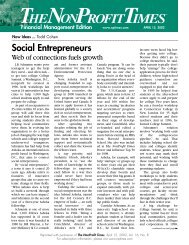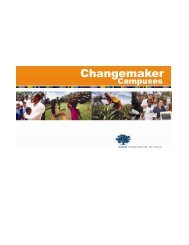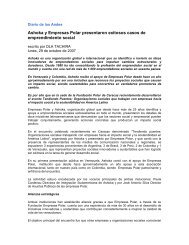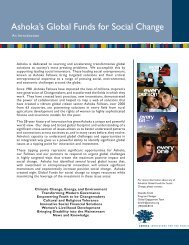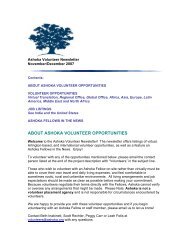Access to Energy for the Base of the - Ashoka
Access to Energy for the Base of the - Ashoka
Access to Energy for the Base of the - Ashoka
You also want an ePaper? Increase the reach of your titles
YUMPU automatically turns print PDFs into web optimized ePapers that Google loves.
Despite its size, <strong>the</strong> BOP energy market is fragmented<br />
and immature. <strong>Energy</strong> needs and solutions change from<br />
country <strong>to</strong> country, rural <strong>to</strong> urban, wet season <strong>to</strong> dry. Few<br />
intermediaries exist <strong>to</strong> describe <strong>the</strong> market, aggregate<br />
demand, and provide finance or technical assistance.<br />
Multilateral and government ef<strong>for</strong>ts have put only a dent<br />
in <strong>the</strong> need <strong>for</strong> access <strong>to</strong> energy; most <strong>to</strong>p-down and<br />
subsidy-based approaches have failed. In addition, <strong>the</strong><br />
lives <strong>of</strong> poor people differ according <strong>to</strong> common<br />
categories such as rural and urban, or in<strong>for</strong>mal and <strong>for</strong>mal<br />
workers, as well as between people at <strong>the</strong> same income<br />
level, <strong>the</strong> same city, and even <strong>the</strong> same street.<br />
The combination <strong>of</strong> pressing social need and stalled<br />
traditional approaches is prime terri<strong>to</strong>ry <strong>for</strong> social<br />
entrepreneurs. For decades, social entrepreneurs have<br />
been expanding <strong>the</strong> realm <strong>of</strong> possibility in access <strong>to</strong><br />
energy. Solutions such as unsubsidized solar LED lanterns<br />
or rural cooperatives are <strong>the</strong> result <strong>of</strong> <strong>the</strong> dauntless<br />
determination and innovation <strong>of</strong> social entrepreneurs.<br />
Local private companies and multinational corporations<br />
(MNCs) also have been experimenting with access<br />
<strong>to</strong> energy initiatives, and <strong>the</strong> results serve hundreds <strong>of</strong><br />
thousands <strong>of</strong> low-income people.<br />
The trends highlighted in this report show a<br />
convergence <strong>of</strong> <strong>the</strong> private and <strong>the</strong> citizen sec<strong>to</strong>rs - a new<br />
way <strong>of</strong> working that can trans<strong>for</strong>m access <strong>to</strong> energy, and<br />
provide social impact and financial returns. 5<br />
The purpose <strong>of</strong> this document is <strong>to</strong> articulate <strong>the</strong><br />
promising cases that have emerged from decades <strong>of</strong><br />
experimentation, describe trends in successful business<br />
models, and chart a path <strong>for</strong> a trans<strong>for</strong>mation in <strong>the</strong><br />
access <strong>to</strong> energy market, one that brings clean, safe,<br />
af<strong>for</strong>dable energy <strong>to</strong> billions.<br />
While <strong>the</strong> projects we identified are remarkably diverse,<br />
<strong>the</strong>ir business models can be regrouped in four categories:<br />
1. Grid connections turn slum communities in<strong>to</strong><br />
legal, paying cus<strong>to</strong>mers using community organizing,<br />
technological innovation, and complementary<br />
business lines. These enterprises, in Sudan, Colombia,<br />
or Argentina, are economically viable without<br />
subsidies and very attractive <strong>to</strong> <strong>the</strong>ir cus<strong>to</strong>mers. With<br />
some work <strong>to</strong> overcome hesitations from utilities and<br />
slum dwellers, grid connections could reach more <strong>of</strong><br />
<strong>the</strong> 1b people currently living in slums.<br />
2. Devices such as solar lanterns and efficient<br />
biomass cooks<strong>to</strong>ves provide energy <strong>for</strong> lighting and<br />
cooking and are af<strong>for</strong>dable <strong>to</strong> <strong>the</strong> poorest <strong>of</strong> <strong>the</strong><br />
poor. Both solar lantern and cooks<strong>to</strong>ve enterprises<br />
demonstrate high potential <strong>for</strong> pr<strong>of</strong>itability, and are<br />
receiving social venture capital. Growth goals are<br />
ambitious and entrepreneurs expect significant<br />
scale over <strong>the</strong> coming years.<br />
3. Solar home systems (SHS) provide electricity <strong>for</strong><br />
households and home-based entrepreneurs with a<br />
stand-alone solar pho<strong>to</strong>voltaic panel wired in<strong>to</strong> lamps<br />
and a plug. SHS enterprises have demonstrated pr<strong>of</strong>itability,<br />
but are vulnerable <strong>to</strong> <strong>the</strong> expectation <strong>of</strong> free<br />
help from governments and <strong>the</strong> swings in input prices<br />
that have characterized <strong>the</strong> solar PV market. SHS<br />
entrepreneurs expect strong growth, and are working<br />
<strong>to</strong> reduce complexity in <strong>the</strong>ir operating models.<br />
4. Rural cooperatives take <strong>the</strong> challenge <strong>of</strong> providing<br />
sustainable power supply and create income generation<br />
opportunities that increase people’s ability <strong>to</strong><br />
pay <strong>for</strong> <strong>the</strong> electricity generated. Such models are<br />
technologically neutral as <strong>the</strong>y can use biomass<br />
gasification, wind, or hydro. But rural cooperatives<br />
require local maintenance and administration and<br />
<strong>of</strong>ten an ef<strong>for</strong>t <strong>to</strong> set up local enterprises <strong>to</strong> use <strong>the</strong><br />
increased power supply. Economic viability is possible<br />
in <strong>the</strong>ory but remains an unmet challenge.<br />
Expanding rural cooperatives requires complex<br />
relationships between governments, enterprises,<br />
and communities.<br />
5 See http://ashoka.org/citizensec<strong>to</strong>r <strong>for</strong> a definition <strong>of</strong> <strong>the</strong> citizen sec<strong>to</strong>r - <strong>the</strong> activities carried out by citizens, defines as what <strong>the</strong>y do. This definition goes<br />
beyond being not businesses (non-pr<strong>of</strong>its) or not governments (NGOs). The term CSOs is used <strong>to</strong> describe a new generation <strong>of</strong> citizen engagement.<br />
11


